Artillery in Canada: German First World War Artillery - historic photos of the guns captured by Canadians
German First World War Artillery captured by Canadians
Photos from the Library and Archives Canada collection.
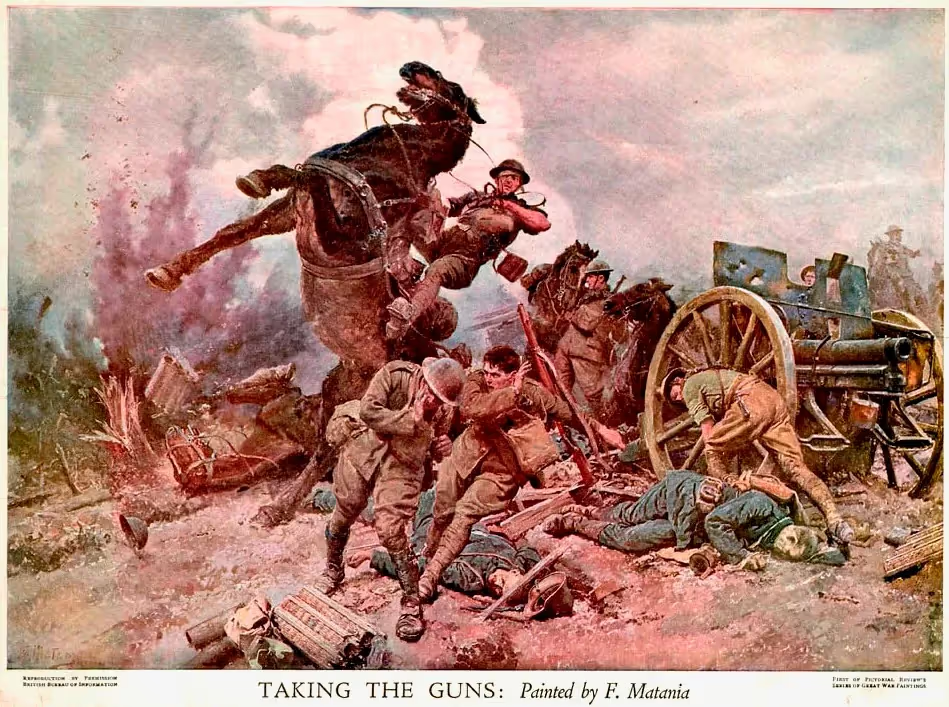
(Library and Archives Canada Photo, MIKAN No. 3636763)
Painting of Canadians capturing a German First World War 7.7-cm Feldkanone 96 neuer Art (7.7-cm FK 96 n.A.), entitled "Taking the Guns", ca 1918, by Forunino Matania.

(Library and Archives Canada Photo, MIKAN No. 3397896)
German First World War 7.7-cm Feldkanone 96 neuer Art (7.7-cm FK 96 n.A.) captured by Canadians near Amiens, France, Aug 1918. This gun was known as the "Whiz Bang".

(Library and Archives Canada Photo, MIKAN No. 3397885)
German First World War 7.7-cm Feldkanone 96 neuer Art (7.7-cm FK 96 n.A.) captured by Canadians near Farbus, France, Feb 1918.

German 7.7-cm Feldkanone 96 n.A. with crew.

(Library and Archives Canada Photo, MIKAN No. 3397939)
Damaged German 7.7-cm Feldkanone 96 n.A. near Buissy. Captured during the advance East of Arras, September, 1918.
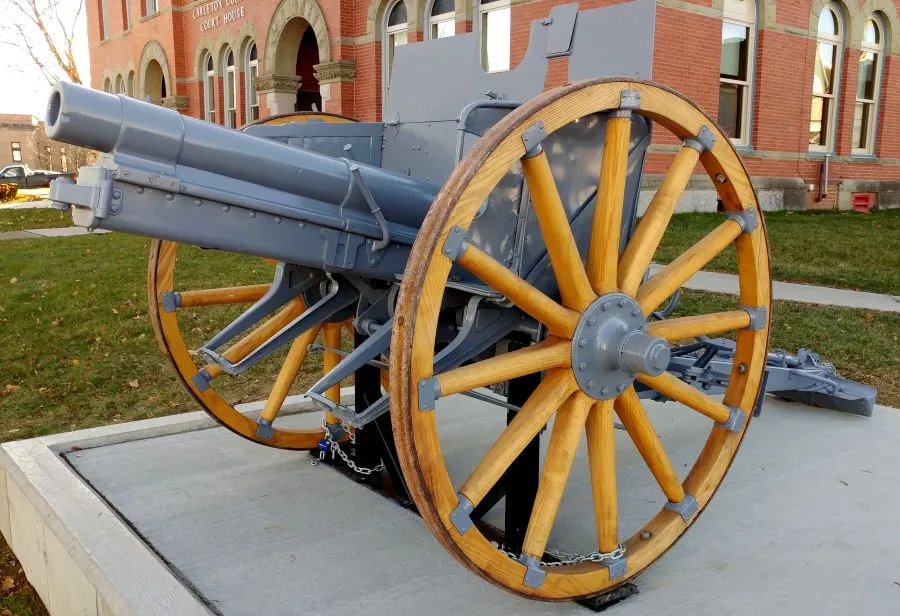
(Author Photo)
German First World War 7.7-cm Feldkanone 96 neuer Art (7.7-cm FK 96 n.A.), (Serial Nr. 2398), no data. This FK 96 was likely captured ca 1918 by a Battalion of an Infantry Brigade in a Canadian Division with the Canadian Expeditionary Force (CEF), in France. In July 1920, T. W. Caldwell, MP for Carleton-Victoria, secured this Gun from the Government of Canada for Woodstock. It was placed on the county lot in front of the Courthouse in a dedication ceremony on 7 Nov 1921. It was taken into the 89th Field Battery's Major J.D. Winslow Armoury in 2012, and underwent an extensive restoration. Kings Landing built a new set of wooden wheels to the specifications of the originals. This involved an extensive search for the right wood, which was eventually found in Nova Scotia. BID in Woodstock sandblasted the metal parts and repainted the gun in standard grey, the colour chosen for all non-Allied weapons on display. The gun was placed on a freshly poured concrete pad donated by Keenan Construction in Bedell, at its display site in front of the Carleton County Courthouse on 31 Oct 2017.

(Library and Archives Canada Photo, MIKAN No. 3397926)
German First World War artillery captured East of Arras, Aug 1918.

(Library and Archives Canada Photo, MIKAN No. 3397927)
German First World War artillery captured East of Arras, Aug 1918. (Library and Archives Canada Photo, MIKAN No. 3397927)

(Library and Archives Canada Photo, MIKAN No. 3397933)
German First World War artillery captured East of Arras, Aug 1918.

(Library and Archives Canada Photo, MIKAN No. 3397965)
German 7.7-cm FK 16 and other guns captured by Canadians following the advance on Cambrai, November 1918.

(Author Photo)
German First World War 7.7-cm Feldkanone 16 (7.7-cm FK 16), (Serial Nr. 13820). This gun was captured on 29 Sep 1918 by the 25th Battalion (Nova Scotia Rifles), 6th Infantry Brigade, 2nd Canadian Division, Canadian Expeditionary Force (CEF), at Moon Quarry near Cherisy, France. No. 1 of 2 German guns in the Memorial Park.
The 7.7 cm Feldkanone 16 (7.7 cm FK 16) was a German field gun with a longer range than the FK 96 n.A. The barrel is longer and the gun has a box carriage to allow for greater elevation, which increased the range. It also has separate-loading ammunition to reduce powder consumption and barrel wear at short ranges, although this had the drawback of reducing the rate of fire compared to the older gun. It was prematurely rushed into production in 1916 and early guns suffered from a number of defects, mainly stemming from the German use of substitute materials to reduce consumption of strategic metals. It also suffered from a large number of premature detonations of its shells during 1916.

(Library and Archives Canada Photo, MIKAN No. 3397826)
German Lanz trench mortar captured by Canadians, May 1917.
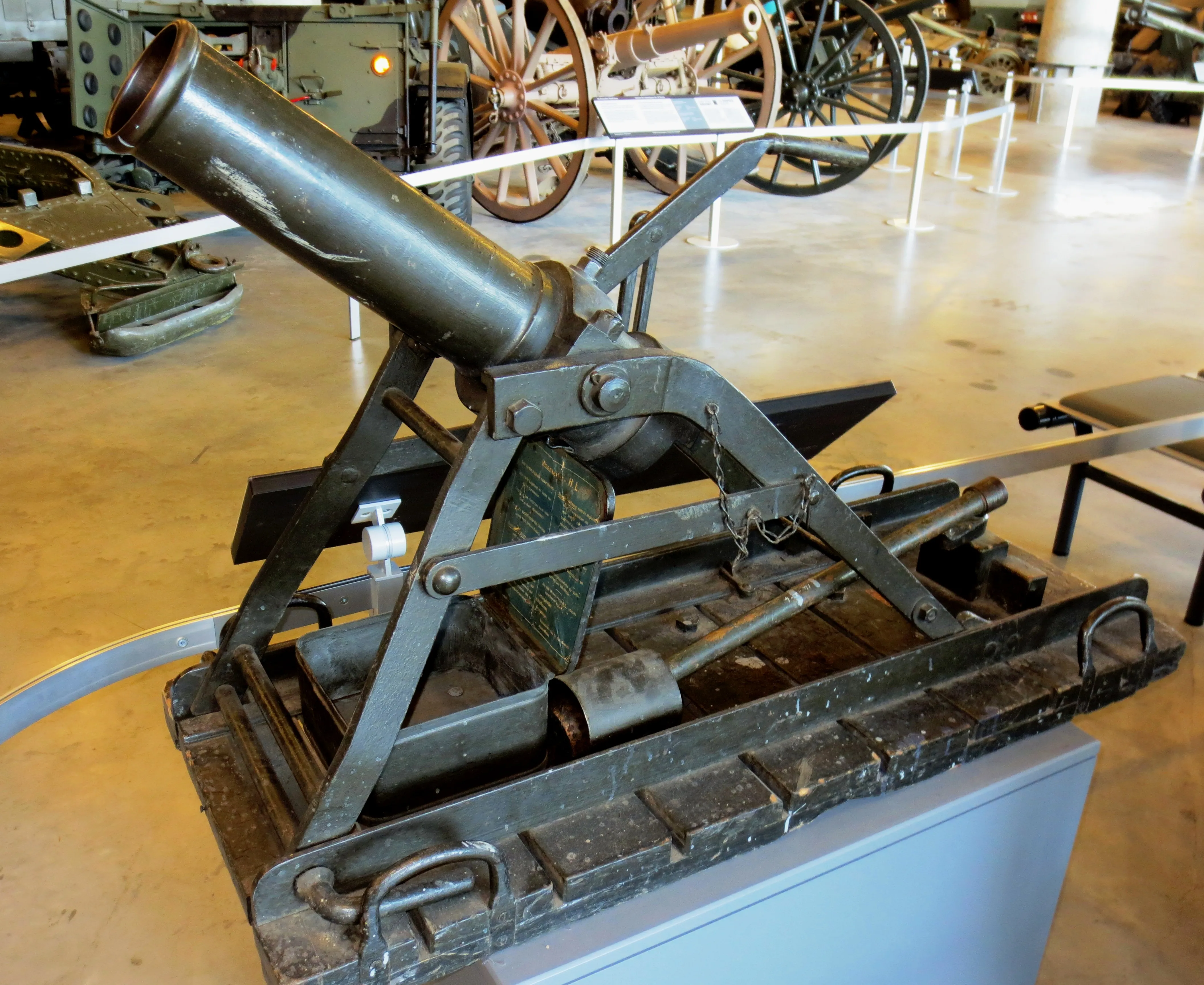
(Author Photo)
German First World War 9.15-cm leichtes Minenwerfer System Lanz, (Serial Nr. 4785JP). Captured by the 18th Battalion at Vimy on 9 April 1917. The Lanz Minenwerfer was a crude pattern of trench mortar that quickly became obsolete. Its main advantages were simple construction, and light weight. The entire weapon platform had to be lifted and turned in order to traverse the mortar. CWM 19940001-018. Canadian War Museum, Ottawa.
The 9.15 cm leichtes Minenwerfer System Lanz (Trench mortar) was a light mortar used by Germany and Austria-Hungary in the First World War. It was a smoothbore, breech-loading design that used smokeless propellant. It was chosen by the Austrians as an interim replacement for their 9 cm Minenwerfer M 14, pending development of a superior domestic design, which eventually turned out to be the 9 cm Minenwerfer M 17. The older Austrian design had a prominent firing signature, a less effective bomb and shorter range than the Lanz. Over 500 were ordered with deliveries beginning in April 1917.

(Library and Archives Canada Photo, MIKAN No. 3397938)
German First World War MG 08 machine-guns in a wagon towing a wheeled 7.58-cm leichtes Minenwerfer neuer Art, (7.58-cm leMW n.A.) trench mortar captured by Canadians during the advance east of Arras, France, Sep 1918.
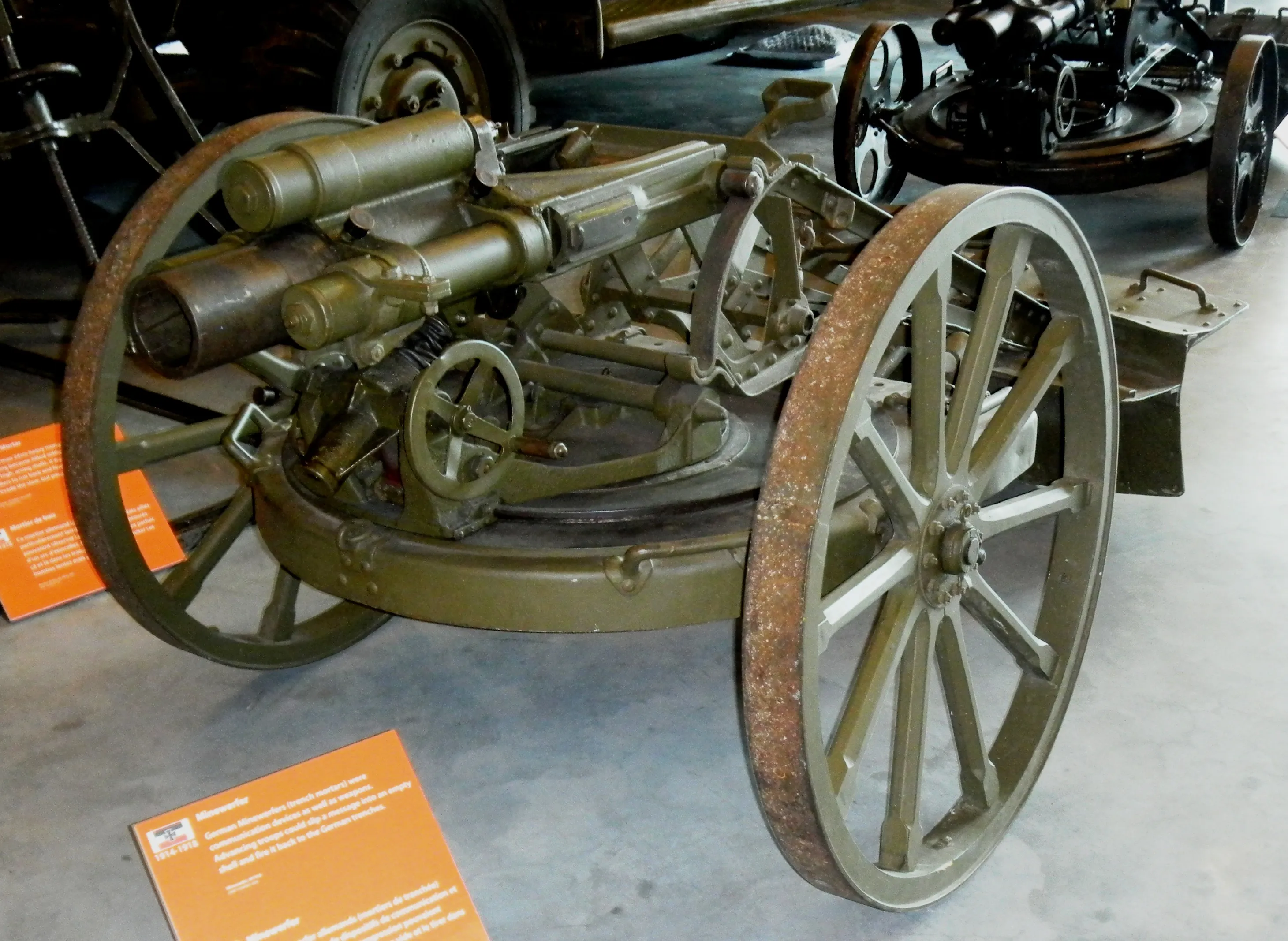
(Author Photo)
German First World War 7.58-cm leichtes Minenwerfer neuer Art (7.58-cm leMW), (Serial Nr. 5160), AEG M1916, rifled, stamped 2108625, jk, 2660, 5169, mounted on wooden carriage wheels. Captured by the 20th Battalion at the Cité St. Emile, North of Lens, France, on 15 August 1917. This leMW n.A. is marked “captured and claimed by the 3rd Can TM” on the rotator/base plate (most likely the 3rd Canadian Trench Mortar Battery). Canadian War Museum, Ottawa.

(Library and Archives Canada Photo, MIKAN No. 3397956)
German First World War 7.58-cm leichtes Minenwerfer neuer Art, (7.58-cm leMW n.A.) wheeled trench mortar captured by Canadians during the advance East of Arras, October 1918.

(Library and Archives Canada Photo, MIKAN No. 3403179)
Canadian soldier examining a German First World War 7.58-cm trench mortar as German prisoners carrying their wounded pass by him during the advance East of Arras, France, Aug 1918.

(Library and Archives Canada Photo, MIKAN No. 3397962)
German trench mortars captured by Canadians, Oct 1918.

(Library and Archives Canada Photo, MIKAN No. 3521829)
Captured German trench mortars being examined by Canadians, Apr 1917.

(Library and Archives Canada Photo, MIKAN No. 3194349)
German trench mortars captured by Canadians, Canal du Nord, Oct 1918. (Library and Archives Canada Photo, MIKAN No. 3194349)

(Library and Archives Canada Photo, MIKAN No. 3521845)
German 17-cm mittlerer Minenwerfers (17-cm mMW), captured by Canadians, Apr 1917.

(Author Photo)
German First World War 17-cm mittlerer Minenwerfer (17-cm mMW), (Serial Nr. 848), stamped Rh.M.F. 1916. This trench mortar was captured on 8 Aug 1918 by the 16th Battalion (Canadian Scottish), 3rd Infantry Brigade, 1st Canadian Division, Canadian Expeditionary Force (CEF) near Aubercourt, France. Originally allocated to Stamford, Ontario, this mMW was collected by Tom Skelding, held at the Armour School, CFB Gagetown for a number of years, and donated to the PEIR in 2013. It is currently on display outside the Armoury.
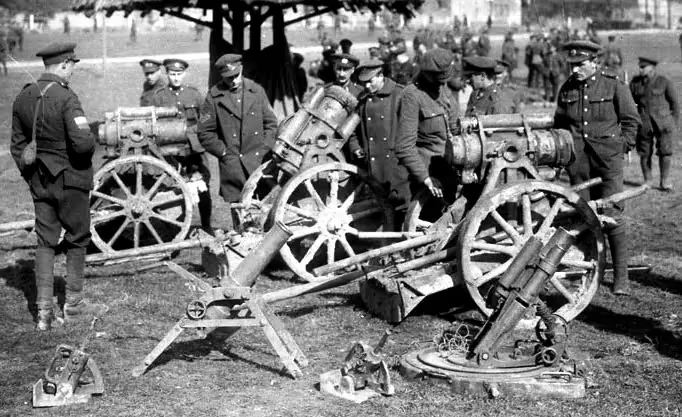
(Library and Archives Canada Photo, MIKAN No. 3521871)
German trench mortars captured by Canadians, Apr 1917.

(Library and Archives Canada Photo, MIKAN No. 3213518)
German trench mortars captured by Canadians, May 1917, LGen Julian Bing.

(Library and Archives Canada Photo, MIKAN No. 3397922)
Captured German MG 08 machine guns, trench mortars and AA Guns, Amiens, Aug 1918.

(Library and Archives Canada Photo, MIKAN No. 3397823)
German 7.92-mm MG 08 machine guns captured at Vimy Ridge, May 1917.

(Author Photo)
German First World War 7.92-mm Maxim Spandau MG 08 Machinegun, possibly (Serial Nr. 1712), mounted on a Schlitten stand. This MG 08 was captured on 27 Sep 1918 by the 78th Battalion (Winnipeg Grenadiers), of the 12th Brigade within the 4th Canadian Division of the Canadian Expeditionary Force (CEF) in France. The Army Museum, Halifax Citadel, Nova Scotia.

(Library and Archives Canada Photo, MIKAN No. 3403105)
German 7.92-mm MG08 assembly, May 1917.

(Library and Archives Canada Photo, MIKAN No. 3522120)
German First World War 7.92-mm Maxim Spandau MG 08/15 machine-gun being examined by Canadian Motor Machine Gun Brigade Officers, March 1918.

(Author Photo)
German First World War 7.92-mm Maxim Spandau MG 08/15 Machinegun, (Serial Nr. 2849), Gwf Spandau, 1918. This weapon was captured ca 1918 by the 78th Battalion (Winnipeg Grenadiers), 12th Infantry Brigade, 4th Canadian Division, Canadian Expeditionary Force (CEF), South of Passchendaele, France. Herman J. Good VC, Branch No. 18, Royal Canadian Legion War Museum, Bathurst, New Brunswick.

(Library and Archives Canada Photo, MIKAN No. 3397916)
Captured German 3.7-cm Maxim Flak M14 Anti-aircraft Gun, Amiens, Aug 1918. This was a version of the 37-mm Maxim-Nordenfelt AA gun produced in Germany for both the Navy and Army.
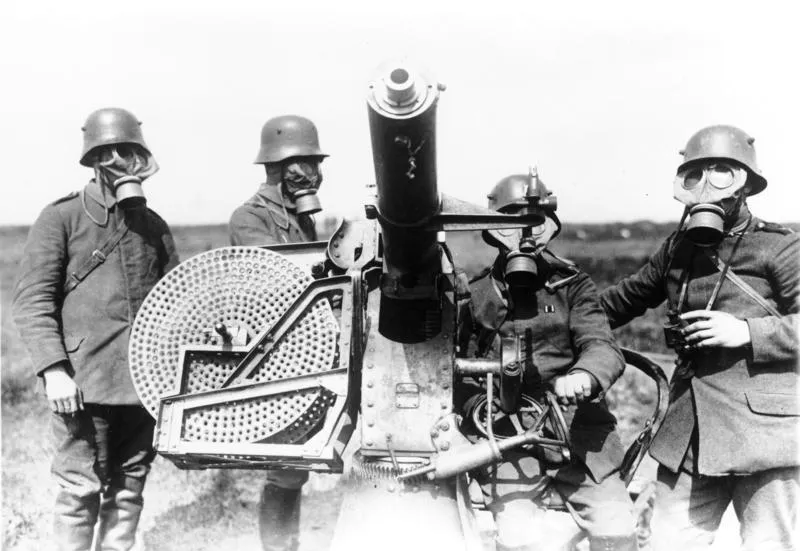
(Bundesarchiv, Bild 183-R52907)
German Maxim Flak M14 manned by four German gunners wearing gasmasks, c1916-1918.
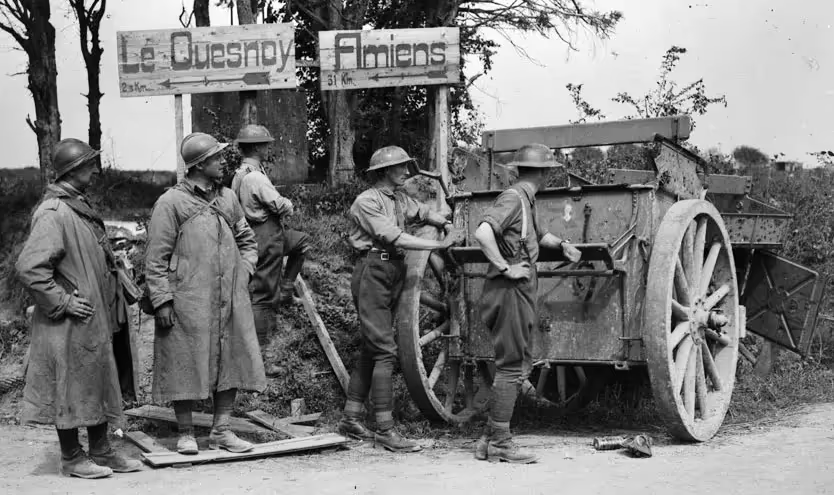
(Library and Archives Canada Photo, MIKAN No. 3397396)
Canadian and French soldiers with German ammunition wagon, Amiens, Aug 1918.

(Library & Archives Canada Photo, MIKAN No. 3396816)
French de Bange 155-mm long cannon mle. 1877 (155 L de Bange) field gun, Battle of Amiens, captured by the Germans and recaptured by the Canadians, Aug 1918.

(Library and Archives Canada Photo, MIKAN No. 3397889)
French de Bange 155-mm long cannon mle. 1877 (155 L de Bange) field gun, used by the Germans and captured by Canadians at thge Battle of Amiens, Aug 1918.
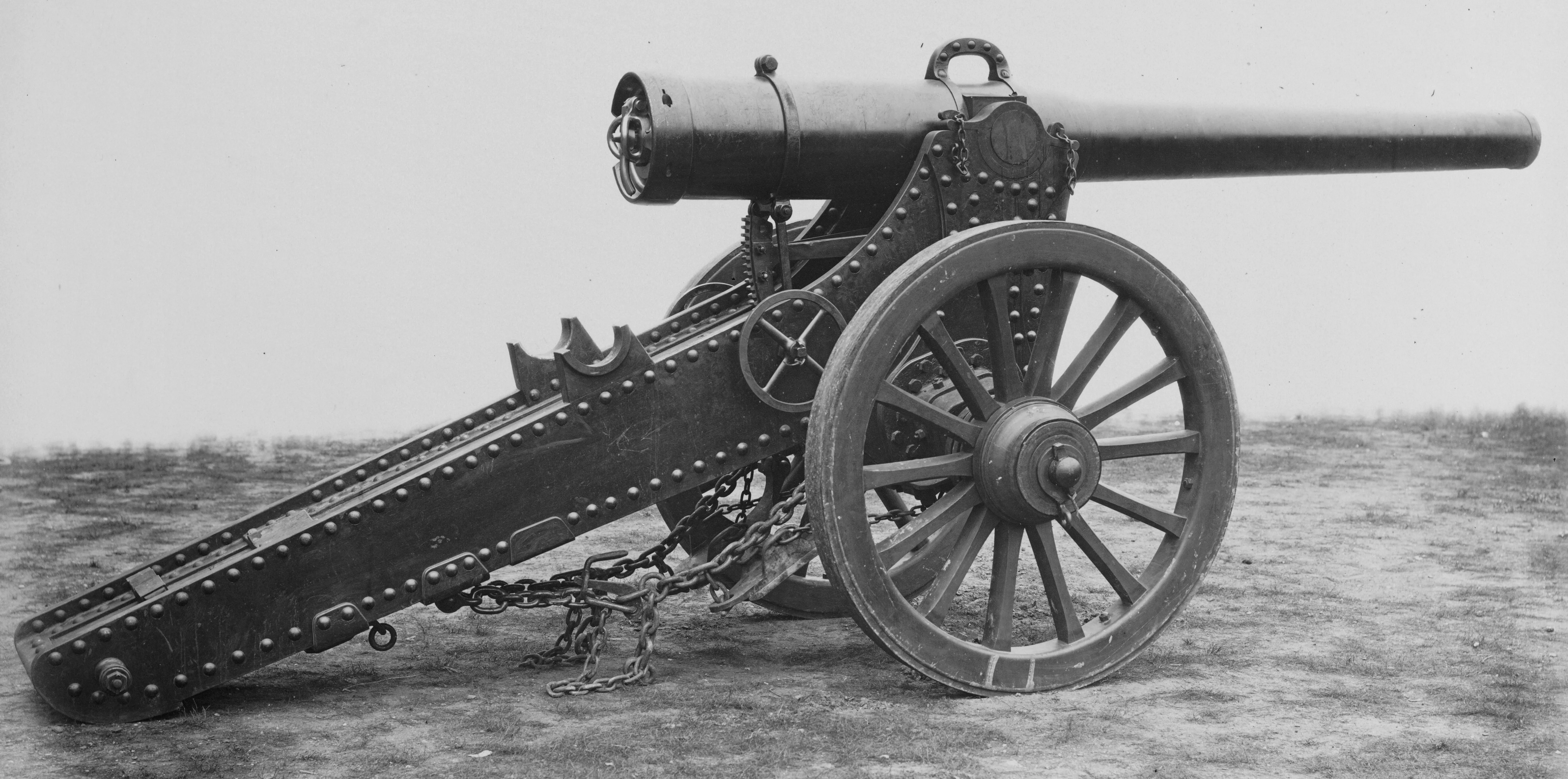
(Bibliothèque nationale de France Photo)
The de Bange 155 mm long cannon mle. 1877 (or more promptly known as the 155 L de Bange) was the French artillery piece that debuted the 155 mm (6.1 in) caliber, which is still in widespread use across the world today. Although obsolete by the beginning of the First World War, the 155 L de Bange was nonetheless pressed into service and became the main counter-battery piece of the French army in the first two years of the war.

(Library and Archives Canada Photo, MIKAN No. 3397890)
French de Bange 155-mm long cannon mle. 1877 (155 L de Bange) field gun, Battle of Amiens, captured by the Germans and recaptured by the Canadians, Aug 1918.

(Library and Archives Canada Photo, MIKAN No. 35222222)
French de Bange 155-mm long cannon mle. 1877 (155 L de Bange) field gun, Battle of Amiens, captured by the Germans and recaptured by the Canadians, Aug 1918.

(Library & Archives Canada Photo, MIKAN No. 3397889)
French de Bange 155-mm long cannon mle. 1877 (155 L de Bange) field gun, Battle of Amiens, captured by the Germans and recaptured by the Canadians, Aug 1918.

(Author Photo)
German First World War 15-cm schwere Feldhaubitze 1902 (15-cm sFH 02), (Serial Nr. 86), A.G. Essen, 1904. This sFH 02 was likely captured ca 1918 by a Battalion of an Infantry Brigade in a Canadian Division with the Canadian Expeditionary Force (CEF), in France. It was originally allocated to Charlottetown. The sFH 02 is on display outside the Kensington Veteran’s Memorial Military Museum, next to Royal Canadian Legion Branch No. 9.
The 15 cm schwere Feldhaubitze 1902 (15 cm sFH 02) was a German heavy field howitzer introduced in 1903. It was the first artillery piece to use a modern recoil system in the German Army. Some 416 were in service at the beginning of the war. Its mobility, which allowed it to be deployed as medium artillery, and fairly heavy shell gave the German army a firepower advantage in the early battles in Belgium and France in 1914 as the French and British armies lacked an equivalent.

(Library and Archives Canada Photo, MIKAN No. 3397897)
Captured German 15-cm schwere Feldhaubitze 1902 (15-cm sFH 02) Heavy Field Howitzer, Amiens, Aug 1918.

(Library and Archives Canada Photo, MIKAN No. 3397887)
Captured German 15-cm schwere Feldhaubitze 1902 (15-cm sFH 02) Heavy Field Howitzer, Amiens, Aug 1918.

(Library and Archives Canada Photo, MIKAN No. 3397953)
German First World War 10.5-cm Feldhaubitze 98/09 (10.5-cm FH 98/09), captured by Canadians near Vis en Artois, France, Sep 1918.

(Réjean Montmarquet Photo)

(Library and Archives Canada Photo, MIKAN No. 3521875)
German 10.5-cm FH 98.09 Gun, captured by Cdns, 17th Bty, CFA, being used to fire on Germans, Apr 1917.

(Library and Archives Canada Photo, MIKAN No. 3194730)
17th Battery RCA firing a captured German 10.5-cm leFH 98/09 Howitzer on retreating German forces at Vimy Ridge, April 1917.

(Library and Archives Canada Photo, MIKAN No. 3521832)
German First World War 15-cm schwere Feldhaubitze 13 (15-cm sFH 13) Heavy Field Howitzer, captured by Canadians, Farbus Village, France, Apr 1917.

(Terry Honour Photo)
German First World War 15-cm schwere Feldhaubitze 13 (15-cm sFH 13), (Serial Nr. 2634), heavy field howitzer. This sFH 13 stands in front of the Legion. Originally No. 1 of 2, previously in front of the Colonial Building. St. John's, Newfoundland.

(Library and Archives Canada Photo, MIKAN No. 3397894)
German 10-cm K 17 Field Gun captured at Amiens, France, Aug 1918.
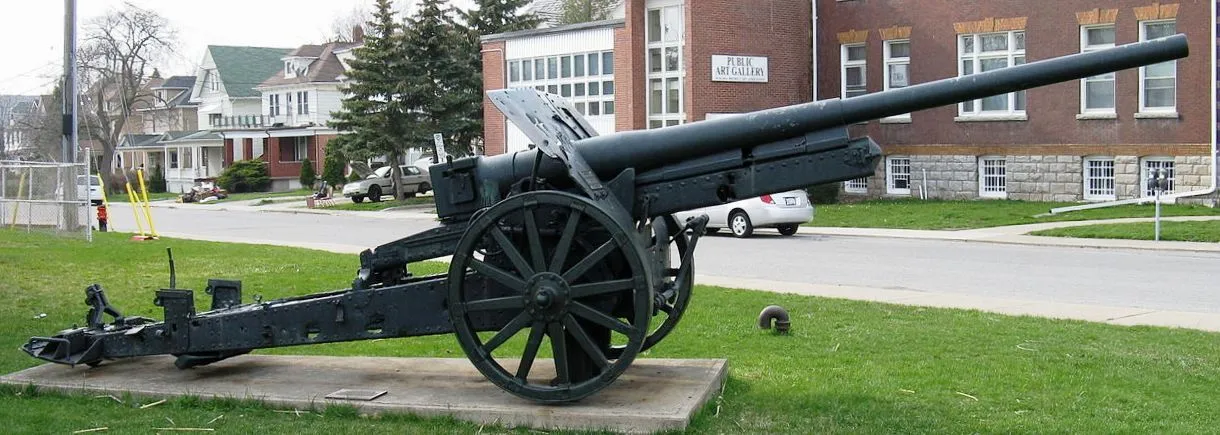
(Balcer Photo)
German First World War 10.5-cm Kanone 17 (10.5-cm K 17), (Serial Nr. 39), 1918. It was captured by the 3rd Battalion on 27 Sep 1918 near the Arras-Cambrai Road between Marquion and Raillencourt, France. Niagara Military Museum previously located with D Company, Lincoln & Welland Regiment (Victoria Street) Armoury, 5049 Victoria Ave.

(Library and Archives Canada Photo, MIKAN No. 3521837)
German First World War 8-inch Naval Gun captured at Farbus, France, Apr 1918.
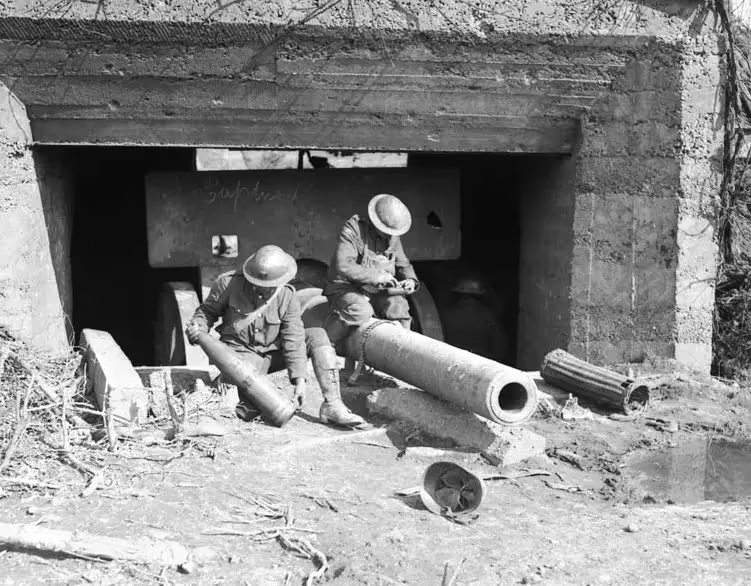
(Library and Archives Canada Photo, MIKAN No. 3521833)
German Great War 8-inch Naval Gun, captured at Farbus, Apr 1918.

(Library and Archives Canada Photo, MIKAN No. 3397937)
German 8.8-cm AA Gun, captured by Canadian East of Aras, Sep 1918.

(Library and Archives Canada Photo, MIKAN No. 3397921)
German 8.8-cm Flak 16 AA Gun examined by Canadians, Battle of Amiens, Aug 1918.

(Library and Archives Canada Photo, MIKAN No. 3397899)
German First World War 21-cm Mörser gun being examined by a Canadian Officer, Arras, Aug 1918. CANADA scratched on the barrel.
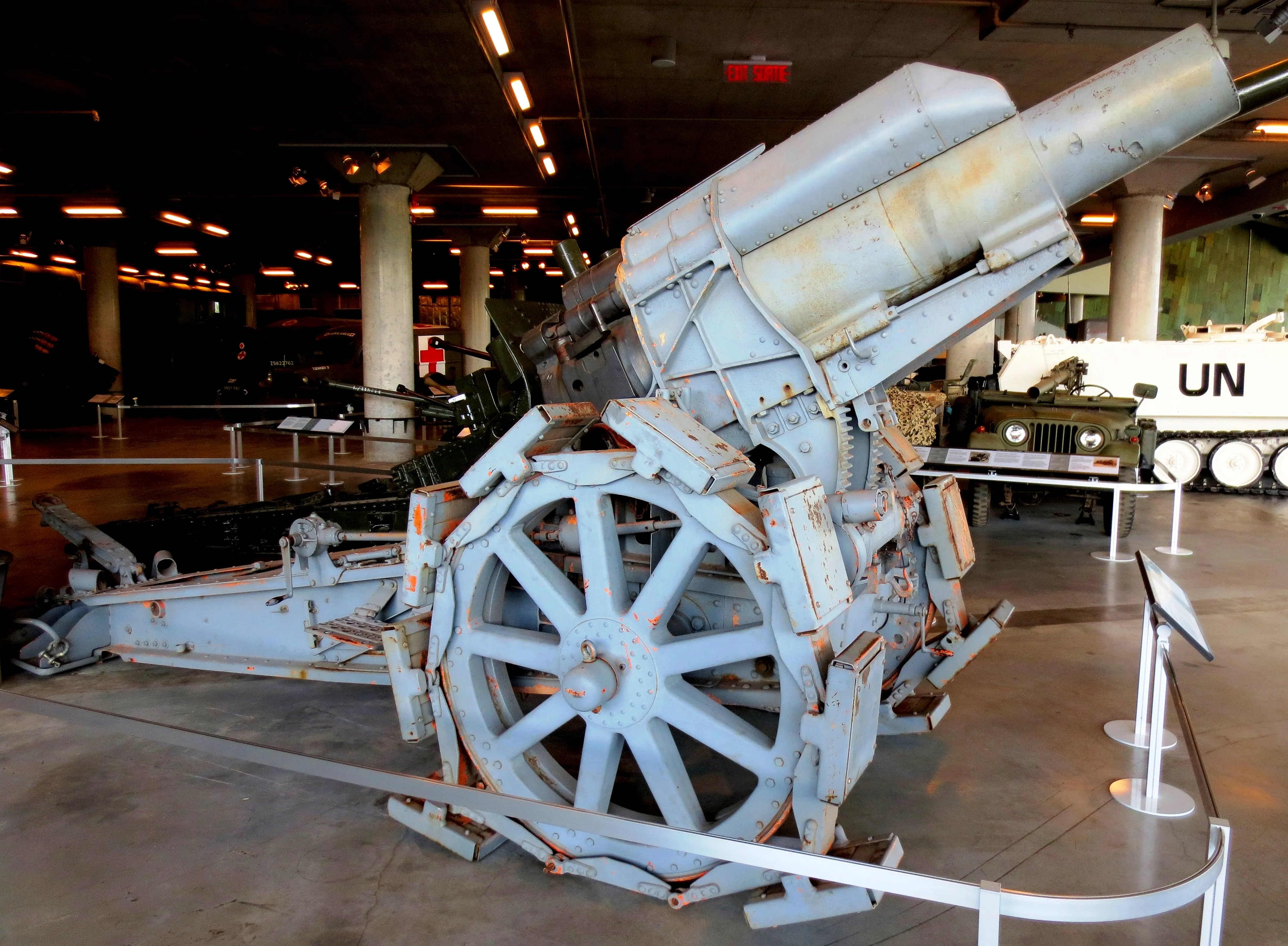
(Author Photo)
German First World War 21-cm Mörser 1910 neuer Art Heavy Mortar, (Serial Nr. 679), Krupp AG, Essen, 1916. Captured by the 18th Battalion. Originally allocated to Hamilton, Ontario. There aren't very many of these 21-cm 21-cm Mörsers left in the world. Of the three that survive in Canada, there is this 1910 model in the Canadian War Museum in Ottawa, another 1910 model in Battlefield Park, Quebec City Park) and a 1916 model in the Quebec Citadel.
In the UK, there are three 1910 models, with one each at Bovington, Duxford, and Inniskilling. Australia has two 1910 models with one each at Childers and Melbourne, and three 1916 models, with one each at the Australian War Museum Canberra, another at Hobart and the third (with a blown barrel) in the Australian War Museum at Mitchell. Another 1916 model is with the Peter Jackson collection at Omaka, New Zealand.
In the USA, there are four 1910 models with one each at Bloomington, Illinois, Clackamas, Oregon, Hickory, North Carolina, and Lowell, Montana). There are ten 1916 versions, with one each at Waterbury, Connecticut (Serial Nr. 1233), Kennedy Park, Fall River, Massachusetts (Serial Nr. 839), Fort Meade, Maryland, Fort Sill, Oklahoma, Columbus, Kansas, Harrisonburg, Virginia, (Serial Nr. 913) Newport News, Virginia Wars Museu, Virginia (Serial Nr. -82), Victoria, Virginia (Serial Nr. 883), Corporal Willis S.Cole Military Museum, Kirtland, Washington, and Spring Green, Wisconsin (locked in full recoil position, damaged).
One is located at Spandau, Germany, one 1916 model is with the Musée Royal de l'Armée (presented with the tube in transport position on a Rohr Wagon) in Brussels, Belgium, and one 1916 version is with the Finnish Artillery Museum at Hameenlinna, Finland.

(Library and Archives Canada Photo, MIKAN No. 3397957)
German First World War 21-cm Mörser howitzer captured by Canadians during the advance East of Arras, October, 1918.

German First World War 21-cm Mörser howitzer being examined by a Canadian Officer, Arras, Aug 1918. CANADA scratched on the barrel.
The forces on opposite sides of the First World War learned to use artillery in massive concentrations of fire power. The carnage caused by the massive destructive power of the guns on all fronts helped lead to the stalemate of trench warfare. To try and overcome this, three techniques were developed to try and break the opposition. The French used a system known as rafale (gale wind) which involved a heavy bombardment of shells on enemy forces. Although there were terrible losses, the shells did not completely destroy enemy defences including barbed wire. The shell holes created additional obstaclesthat made movement even more difficult, with the end result that attacks did not succeed.
The barrage system was developed to make use of the increasing sophistication and availability of high explosive shells. Although it stil caused tremendous casualties, improved defence positions negated the effects of the bombardments, and attacks again failed to gain significant ground. The creeping barrage was developed to bombard the ground just ahead of the infantry, with the barrage being lifted and moved forward as the troops advanced. The enemy lines did not break.
The method of massing large numbers of guns firing a combination of gas and artillery shells was implemented to break enemy morale. This technique of firepower employment actually had a measure of success.

(Library and Archives Canada Photo, MIKAN No. 3397825)
German Great War 21cm Morser, captured by 13th Bn, Amiens, Aug 1918.

(Library and Archives Canada Photo, MIKAN No. 3397850)
German Great War 21cm Morser, captured by Canadians at Vimy Ridge, Aug 1917.

(Library and Archives Canada Photo, MIKAN No. 3397851)
German Great War 21cm Morser, captured by Canadians at Vimy Ridge, Aug 1917.

(Library and Archives Canada Photo, MIKAN No. 3397957)
German Great War 21cm Morser, captured by Canadians during the advance East of Arras, Oct 1918.

(Library and Archives Canada Photo, MIKAN No. 3397817)
German Great War 21cm Morsers captured by Canadians at Vimy Ridge, May 1917.

(Library and Archives Canada Photo, MIKAN No. 3397819)
German Great War 21cm Morsers captured by Canadians at Vimy Ridge, May 1917.

(Library and Archives Canada Photo, MIKAN No. 3397919)
General Currie inspecting captured German Great War 21-cm Morsers.

(Library and Archives Canada Photo, MIKAN No. 3397820)
German First World War 21-cm Mörser Heavy Mortar damaged by shellfire, being examined by a Canadian Officer, May 1917.

(Library and Archives Canada Photo, MIKAN No. 3406014)
Canadian troops with captured German Great War 21-cm Morser.

(Library and Archives Canada Photo, MIKAN No. 3397895)
Captured German Great War 21-cm Morser.

(Library and Archives Canada Photo, MIKAN No. 3395091)
German First World War 21-cm Mörser captured by Canadians, 1918.

(Library and Archives Canada Photo, MIKAN No. 3397920)
Captured German 21-cm Morser gun and a 7.7-cm field gun being towed to a Gun Park, Amiens, Aug 1918.

(Library and Archives Canada Photo, MIKAN No. 3397923)
General Currie inspecting captured German Great War Naval Guns.

(Library and Archives Canada Photo, MIKAN No. 3397930)
German Naval Gun captured East of Arras, being examined by civilian VIPs, Aug 1918.

(Library and Archives Canada Photo, MIKAN No. 3397931)
German Naval Gun captured East of Arras, being examined by civilian VIPs, Aug 1918.

(Library and Archives Canada Photo, MIKAN No. 3397915)
General Currie inspecting captured German Great War Naval Guns close in.

(Library and Archives Canada Photo, MIKAN No. 3397914)
General Currie inspecting captured German First World War Naval Guns.

(Library and Archives Canada Photo, MIKAN No. 3397975)
Austrian Mountain Battery Gun captured by Canadians at Cambrai, France, Nov 1918.

(Library and Archives Canada Photo, MIKAN No. 3395388)
Canadian soldiers examining a German anti-tank rifle captured during the Battle of Amiens, France, in front of a British Male tank, August, 1918.

(Canadian Military Photos Lost and Found Photo)
Russian 152-mm howitzer Model 1910 Schneider. The official War Trophy Allocation List dated 13 Feb 1919 records it as: 86, Russian gun, Serial No. 161. It was captured by the 49th Battalion (Edmonton Regiment), which fought as part of the 7th Infantry Brigade, 3rd Canadian Division in France and Flanders until the end of the war. The record notes this gun had initially been ordered to be destroyed on 7 Dec 1916., because a fuzed shell was jammed in the bore as a result of being struck by High Explosive. They must have sorted it out, because it was allocated to Thetford Mines in 1919.

(Military Review Photo)
Russian 152-mm howitzer Model 1910 Schneider.





